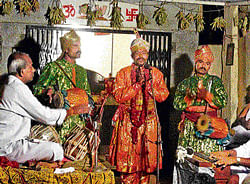A L Venkatesh is a folk artiste who holds the mantle of carrying on the tradition of culture and folk arts from his predecessors. “My grandfather Ramaiah was a director of plays. My father Akkinipalli Lakshman Bhagavatar was a Haridasa and a poet. I practice and perform the art of Burra Katha.

My son A V Guru, who is in the sixth standard can perform Burra katha for at least three hours”, says Venkatesh.
Burra katha is a popular form of folk art in Andhra Pradesh and border areas of Karnataka. It is a narrative entertainment that consists of prayers, solo drama, dance, songs, poems and jokes. The topic will be either a Hindu mythological story or a contemporary social problem.
Burra katha stories fall into three categories - mythological, historical and sociopolitical. Although the form was originally improvised, today popular stories have been written down and committed to memory by performers.
In this theatrical form, a storyteller accompanied by his partner gives recitals for two or three days. He sings dances and recites a story, before the people of a village under the patronage of a village elder.
The term ‘burra’ refers to ‘tambura’, a stringed instrument worn across the right shoulder of the performer.
The main performer plays the tambura with his right hand as he dances rhythmically forward and back on the stage while reciting a story. The performer also wears over his right thumb, a hollow ring in the palm of his hand. With the rings, he beats the basic tempo of the songs.
At regular intervals during the narration he responds to his co-performers, two drummers who play two-headed earthen drums. The drums produce a distinctly metallic sound to accentuate the songs and are regarded as an indispensable ingredient of Burra katha performance.
The drummer to the right of the performer is the ‘rajkiya’. He comments on contemporary political and social issues even if the story concerns historical or mythological events. The drummer on his left, the ‘hasyam’, cracks jokes and provides comic relief.
Performance begins in the evening with devotional songs in praise of various celestial beings. Then the performer introduces the main story by establishing the place, time and historical context of the action. During this the rajkiya and hasyam repeat the refrain of the narrative.
When the introduction is concluded, the main plot begins in which all three performers take an active role assuming various characters in the incidents, as well as providing narrative bridges between incidents. Dance, recitation, song and enactment of scenes provide variation within a strong narrative line. Generally a story continues for two to three hours. A longer work may be serialized into several consecutive evenings.
Recently in Tammanahalli temple there was an all night performance of a Burra katha, “The life history of Kaiwara Thathaiah.” Thathaiah or Naranappa was a 18th century saint who lived in Kaiwara in Chikkaballapur.